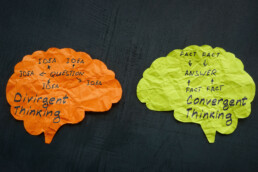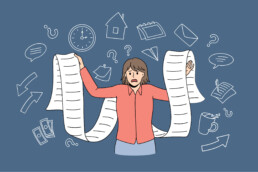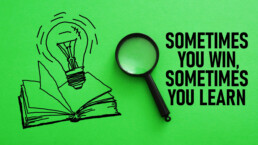The Value of a Planner
How good is your memory? Is short term memory a problem for you? Or is long term memory more difficult? Or are they equal? My memory is all over the place. I went to the market to buy juice and bought everything I hadn’t needed, but no juice. That’s what makes a list important. It’s planning ahead.
To know when your appointments are, or things you want or have promised to do, it makes sense to write them down. And you must write them all in the same place. Thus, a planner. Or a calendar of sorts will do. That way you have one place to turn to every day to see what you’ve got going that day, or to look ahead at the week, or even the month.
There are so many planners out there I could spend hours telling you about them and still not get through them all. There are entire planner systems designed for making and achieving goals. Someone has created a planner for just about every aspect of life. Paper or electronic, you could plan yourself to your last breath. Or you could keep a simple calendar and look at it regularly.
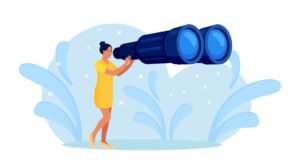 My dentist always asks me about scheduling an appointment six months out from my current appointment. E.g. “Are you free September 4th?” How would I know that? Fortunately, I have a calendar in my phone and can scroll to September, check the date, and enter the dentist appointment. Now I won’t schedule anything else for that time. I may even set a reminder to make sure I leave the house on time.
My dentist always asks me about scheduling an appointment six months out from my current appointment. E.g. “Are you free September 4th?” How would I know that? Fortunately, I have a calendar in my phone and can scroll to September, check the date, and enter the dentist appointment. Now I won’t schedule anything else for that time. I may even set a reminder to make sure I leave the house on time.
I have a friend I have dinner with every Saturday. If I call her earlier in the week to make a plan (in case we need a reservation), she never has an answer. Only on Saturday afternoon can she come up with an idea. She does not have a planner.
To take charge of your life you need to plan how your life will unfold rather than just letting it happen.
Life is never as easy as we plan it to be; however, having a planner makes the bumps of real life easier to deal with.
- Sydney Metrick
Goals vs. Resolutions
Are you a person who makes a list of resolutions at the start of a new year? Do you carry through with them or find that they have fallen by the wayside?
The problem with resolutions is there is little to define them except knowing what it is you want (or don’t want).
Goals, on the other hand, give you a framework to make it more likely you will end up with what you had intended. I’m sure by now you’ve heard of SMART goals. It has become a bit of a buzzword.
Let’s say you want more time in the evenings to relax.
First, your goal must be Specific. More and less are not specific words. If you want “more” free time, you need to define what that looks like to you.
Next is Measurable, this is part of being specific. How much time do you want for evening relaxation? 20 minutes? Two hours?
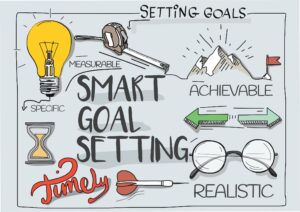 A is for Achievable. It is not likely that you can set aside two hours every evening for relaxation; the 20 minutes, however, is much more achievable.
A is for Achievable. It is not likely that you can set aside two hours every evening for relaxation; the 20 minutes, however, is much more achievable.
Is it Realistic? Given your life and schedule, what would you have to give up or do much faster to carve out two hours of free time every evening?
Finally, Time sensitive. When will you begin doing this? Frequently, goals are something that we need to work up to. Maybe you start with five minutes and increase steadily from there. At what point will you reliably have that desired amount of relaxation time?
Bonus attribute: Accountability. While not required for a SMART goal, it makes success more likely – and sometimes easier. Is there someone, personal or professional, who can check in with you weekly to make sure you’re keeping up?
There you have it—a formula for success. And, since every day is the first day of a new year, you do not need to wait for January to set new goals.
- Sydney Metrick
Overwhelmed?
Do you ever feel overwhelmed? There’s just too much happening at once. You have bills to pay, appointments to make, places to go, organize your house and maybe your office, assignments due, people to take care of, and so on.
 Or have you ever been in a restaurant full of people talking at other tables, and a musician singing loudly in the background?
Or have you ever been in a restaurant full of people talking at other tables, and a musician singing loudly in the background?
What you might be experiencing is sensory overload. When I’m trying to write a newsletter, and someone is mowing their lawn nearby, and a large truck is rambling up the road, and my husband is trying to talk to me, and the phone is ringing, and my sweater itches…you get the picture—sensory overload.
Overwhelm and overload are both too much.
When overwhelmed, take control of your schedule by deciding what’s important and what can wait.
With overload, if you can cut out distractions – put the phone on silent, put on a comfy sweater – do. A pair of noise-canceling earphones can do wonders with overload.
Life happens, there’s no controlling that. It’s up to you to realize it’s normal and find solutions that work for you.
- Sydney Metrick
Why Fidget?
Are you a fidgeter? Do people tell you to stop fidgeting? Well, don’t listen to them. Fidgeting is good for you, especially if you have ADHD. The H stands for “hyperactivity” and fidgeting falls into that category.
Why is fidgeting good? Well, if you’re feeling overwhelmed it can help calm you. If you’re agitated it’s a way to release energy.
On the other hand, if you’re underwhelmed it can get the dopamine in your brain flowing again. Fidgeting keeps your brain awake.
Whether you’re playing with a squeeze ball or a pen, shaking your leg, or twiddling your fingers, there are many ways people fidget.
Physical fidgeting – tapping your foot, bouncing your leg – can help keep blood flowing when sitting for long periods. While not recommended as a dieting technique, fidgeting also burns more calories than just sitting still.
Because focusing on a specific task generally requires only part of the brain, other parts can get bored. Those parts then get distracted and take your focus with them. For many, doing something small and physical gives focus to the parts of the brain not needed for the task at hand.
As an example, I have one client who is positive that if she had understood how to occupy the non-learning sections of her brain at the time, she would have done much better in college. She frequently fell asleep or “spaced out” because she couldn’t appropriately focus on lectures.
By the way, fidgeting is fine for those who do not have ADHD as well. In the age of online everything, we all find ourselves sitting more and for longer periods than what evolution has built us for.
- Sydney Metrick
Do you have ADHD?
Sometimes I get coaching calls from people who say they’re not sure if they have ADHD.
There are so many different symptoms and at various severities that it can be confusing. Add in all the hype, information, and dis-information, and it is easy to understand why adults who are undiagnosed can feel lost.
Because an ADHD diagnosis depends on having multiple symptoms for multiple years, let me offer some of the common behaviors to look for:
 Trouble paying attention, easily distracted
Trouble paying attention, easily distracted- Skipping from one activity to another, not able to persist at an activity for the time required to complete it
- Impulsive behavior
- Restless and fidgety
- Verbally impulsive, blurting out things as they come to mind
- Ideas skipping from one to another
- Don’t always think before acting
ADHD is an executive function disorder. Executive function lives in the frontal lobe of your brain and is your ability to self-regulate and get things done. When executive function is not working correctly, people tend to lose organizational control as well as their ability to properly adapt to situations.
The important thing to keep in mind is that all brain function is chemical. If your brain chemistry is off – due to genetics or environment – there is no permanent solution. However, treatment can provide temporary relief as well as coping mechanisms.
ADHD treatments include medication, therapy/behavior modification, lifestyle changes, or a combination. Figuring out what works best for you is best done with your health care provider.
Personally, coaching helped me. Talking with someone who knows about life with ADHD (not just studied it) kept me from feeling isolated or like I had totally lost my mind.
Three Really Great Problem Solvers!
Do any of these sound familiar?
- You have a great idea in the shower and then forget it by the time you’re dressed.
- A task you thought might take an hour actually takes three.
- You sometimes get so caught up in one thing that you’re late for something else.
- Prioritizing your schedule to address all your “to do’s” feels impossible.
 Solutions exist. I like things to be simple and easy to use so these three tools have passed muster. They are AquaNotes, Time Timer, and Planner Pads.
Solutions exist. I like things to be simple and easy to use so these three tools have passed muster. They are AquaNotes, Time Timer, and Planner Pads.
- Because they say it best, I’m just going to quote from the AquaNotes website: “If you find that some of your best ideas and insights are generated in the tranquility and solitude of the shower...then AquaNotes® is for you! These waterproof notepads help you capture and preserve your ideas before they're forgotten!” The 40 sheet, refillable pad suctions to your shower wall and even comes with matching pen.
- Time Timer has a line of timers, watches, and applications that helps you stay on track. By setting the amount of time you want to spend on a task, Time Timer provides a bright visual of the time gradually elapsing – letting you know when you are getting to the finish – and an alarm to tell you when you are done and need to move on.
- The Planner Pad is an easy-to-use system that help you organize, prioritize, and schedule in ways that make sense. They even have a way of keeping track of items that didn’t get done.
Even the websites are user friendly. Check them out. Let me know if you start using any of them and tell me about your experience.
- Sydney Metrick
How Does Impulsivity Show Up in Your Life?
Do you interrupt when others are talking? Are you just skimming this blog? When you see something you like but don’t need, do you buy it anyway? Are you likely to jump out of something you’re doing into something more interesting? Do you act without thinking? Do have impulsive behaviors?
If you have ADHD, some or all of these may feel familiar.
Is there a solution? Not really, sad to say. It’s matter of calming down and asking yourself if you really need to do or say something right at that time. Awareness is key.
 Awareness, however, can be difficult when dealing with impulsive behaviors – that’s sort of the point.
Awareness, however, can be difficult when dealing with impulsive behaviors – that’s sort of the point.
Google “awareness,” “practicing awareness,” or something similar and you will get results from just about every discipline imaginable – from the American Psychological Association to Harvard Business Review. Of all the Tips, Tools, Exercises, and Ways to become self-aware, there are three out there that seems to come up most often:
- Meditate: Find some way to spend some time with just your brain and learn how to slow things down.
- Keep a Daily Journal: Write down all your reactions, impulses, feelings. No judgements, just what happened.
- Ask a Friend: Talk to someone who cares about you and will tell you the absolute truth – whose opinion matters to you. Ask about your strengths and annoying habits.
Just like with any habit, awareness takes time, practice, and patience. Keep at it, though, it’s worth the trip.
-Sydney Metrick
Are you a divergent or convergent thinker?
…or maybe a little of each? Divergent thinkers are primarily intuitive. A word will unleash a wide variety of remote and original associations. Most creative people and people with Attention Deficit Disorder are divergent thinkers.
Convergent thinking is analytical and linear. STEP is a useful way to think about how convergent thinker’s function. S-strategies, T-time, E-energy, P-perseverance. Instead of being blocked by a new project or assignment, a convergent thinker will come up with a strategy. They will imagine how much time will be needed for the whole and for each part. By doing so they’ll know how much energy is required, and commit to persevering.
Divergent thinkers often find convergent thinking challenging. On the other hand, convergent thinkers tend to find divergent thinkers a bit insane.
Alas, at some point we all need to have some convergent thoughts. By thinking of the STEPs and applying them, we can take on a new task or project without a big confrontation going on in our heads.
- Sydney Metrick
Pandora’s Box
Do you have a drawer o box of things-important things, random things, even things you can no longer recall what they are or why you’ve saved them? There might be greeting cards from people you no longer have a relationship with, a broken item you’d planned to repair, keepsakes that were meaningful once upon a time.
When you notice the box or drawer is full, or maybe you can’t find the thing you were sure was saved there, it might be time for a purging. You can dump the box or drawer onto a table and sort the contents into piles.
- First, “What is this and why am I saving it?” That goes to trash or recycling.
- Then you have the things you know and know you don’t and won’t ever need. Into the trash they go.
- Pile number three is the useful things you probably will need in the future – like an eraser. Put those things in their proper places.
- The last pile is your pile of keepers; the treasures you cannot let go of. Those go back into the box or drawer.
If you find yourself hesitant to begin, remember you might have an “oh that’s where this has been moment.” And you’ll get a few minutes to reminisce over the treasures.
- Sydney Metrick
The Downside of Lists
Do you make lists to help you remember tasks, shopping, phone numbers and other information? Are they to serve as daily reminders? Do you have one very long list, or multiple lists on various scraps of paper or in multiple notebooks?
One person I know has at least nine notebooks, countless pieces of paper, and notes on the back of newspapers and fliers. Many of the lists contain duplicate or even triplicate information!
Sadly, he can rarely find the information he’s looking for, has to research again and maybe start another list.
So, what’s the answer?
For my friend, the first step is consolidation. Once all the lists are in one place, he’ll work on the habit of containment. That will take some time; as he’s committed to the process, though, I’m hopeful.
The next question is, what is each list for?
For the standard to-do list, I suggest two lists: one weekly, one daily, and with the same categories. As you cross things off your daily list, or move them to a different day, you can review your weekly next and decide what would best fit into the space left by a “done!”
If your to-do list has a sub-list – such as what to get once you are at the grocery store – there are two basic options.
- Keep it on the same page so you don’t lose it.
- Keep it on a different page dedicated to the sub-type in the same notebook so that it doesn’t confuse your primary list.
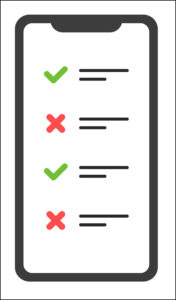 For other types of lists, consolidation is key. For general information lists (books to read, movies to see, names of distant relatives, etc.) using separate sections of the same notebook for different categories can prevent confusion. Special projects may deserve a separate notebook with a section dedicated to lists for the project.
For other types of lists, consolidation is key. For general information lists (books to read, movies to see, names of distant relatives, etc.) using separate sections of the same notebook for different categories can prevent confusion. Special projects may deserve a separate notebook with a section dedicated to lists for the project.
The point is this: if you went to the effort to write the information down, go to the effort of keeping track of it. Keeping track is simpler by using a system of defined steps that WORKS FOR YOU. If paper works for you, great. If you prefer lists in your phone, that’s great too!
Reviewing 2022
Those of us with ADHD or who are in some way not neurotypical, tend to look at what we “should have done” or how we “should have been.” Rather than “shoulding” yourself over things in the past, why not learn from it?
Give yourself some time to review the past year. Look at all your wins, all the things that went well, all you’re proud of. Give yourself a much-deserved pat on the back, do your happy dance, or otherwise celebrate the good.
Also, look at the things that have fallen into your “should” category. Think about what you could do differently in a future similar situation that could lead to successes. Avoid self-criticism, you are teaching yourself how to be better!
With what you now know of your strengths and challenges, what have you learned that can make 2023 a better year for you? For example:
- If you struggle with inattention, what is one thing that can help you with focus?
- If impulsivity is a problem, what can the little voice in your head have as a mantra to slow you down?
- Overwhelmed? Can you practice prioritizing and blocking time for important things?
There is no failure as long as it brings you closer to a future success.
Can You Freeze Time?
Have you ever started to leave the house and remember something you want to do first? It doesn’t matter that you are leaving the house so that you will be on time for your appointment, you just have to get this one thing (or two, or three) done.
For some reason, your brain lets you believe that this 5-minute task will not make you 5 minutes late because time will stop for you. And when the 5 minutes turn into 10, no big deal, time isn’t really passing, right? So, it is really surprising that you end up being late to your appointment.
I am sorry to report that real life has not caught up with science fiction and/or fantasy, time just keeps on ticking away. I have to tell you that “no time at all” is a lie your brain is telling you.
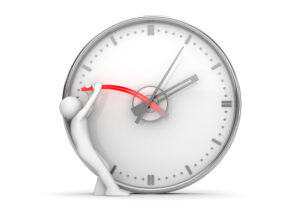 How do you keep track of reality?
How do you keep track of reality?
It helps to have lots of clocks. Have a clock in every room. Analog clocks are more effective as you can see time passing. Look at the clocks frequently. Additionally, for those tasks you only seem to remember at the last minute, write a note. Keep a sticky pad and pen by the door so that you can place the note where you’re sure to see it when you return. Or send yourself a text or voice mail – you can even do that in transit.
Time cushions also help, especially if you include them in your calendar. Cushions give you room for the time an appointment takes that’s not actually appointment time – like travel. I’ve known many people who leave the house when the appointment starts. So, if you need to be somewhere at, say 2 p.m. and travel time in 20 minutes, then the appointment starts (when you leave) at 1:40. I even know a couple of people who have to include the time to get ready (say, getting dressed) in their appointment schedule, otherwise, they wouldn’t get out of bed until the time of their first appointment!
- Sydney Metrick
Remembering to Edit
Do you ever dash off emails, or even blogs, or newsletters and hit “send” before editing? The recommendation for a letter, blog, newsletter, or book, is to put it aside for a day or two and then go back and re-read what you’ve written. Chances are you’ll want to make some changes.
That human brain is a funny thing; after a while, it stops showing you what is actually on the page! Instead, you see what you intended to write. By coming back to it after your brain has cleared up a bit, you regain that fresh (sort of) perspective.
A good way to tell if what you’ve written is free from mistakes and flows well is to read it out loud. You may notice typos, things that could be improved, and possible things that are missing.
If you have attention deficit disorder, like me, you may write that first draft really quickly and just send it off. That’s what I do. But I send it to my editor. Thank you to Lorrie Nicoles.
The Bang for Your Buck
Are you overwhelmed? Do you say yes to too many things, have several projects going at once? Or do you have one project that needs attention, but you don’t know where to begin, or how?
If you have too many things to do, the next question is: What gives you the biggest bang for your buck? When you look at the list of things you’ve said yes to, if everything has the same priority and deadline, think about which project will give you the greatest return on your time and energy investment. And in this case, return can be financial or emotional. If you cannot get rid of anything on the list, order it in terms of biggest bang. You might also want to consider increasing your use of one little word: NO.
If starting the (or one of) project is the problem, ask yourself this: Does it really matter? Starting is the key. Think about the goal and all the factors that lead to the goal. Choose the one that’s most interesting or easiest – the one that gives you the biggest bang. Then build on that.
I recently wrote a book. The contents unfolded in a way that seemed to make sense to me. However, my editor ended up rearranging much of what I had written, and that was okay – that’s why I have an editor. For me, the bang was getting all the thoughts out. You can be your own editor once you get everything out of your head.
-Sydney Metrick
Paper, Paper Everywhere?
Are you inundated with piles of paper? Do you have notes on various pieces of paper? Bills? Lists? Notices? Documents? With so much coming in on a regular basis, it’s easy to become overwhelmed.
But it’s also nearly as easy to create paper systems.
- When paper comes in, determine if it’s trash (toss or shred), information to keep, or something that needs action.
- Get file folders in different colors. These are where you will separate and keep important papers.
- How about colored pads for different lists? You’ll want the colors to match the file categories as much as possible.
- Are there due dates on any of the papers? These are your action items. Put both the start dates and the due dates in your calendar.
- Keep a “Master Pad” that is your go-to source for your To Do list. Check it often and check off when “to do’s” are done.
It’s great to have a file box or file cabinet. Use it. Create a habit of reviewing your lists, calendar, and notes daily.
![]()
![]() You can use similar systems with information that comes electronically.
You can use similar systems with information that comes electronically.
- You have a delete button.
- You can create folders and file messages you want to keep.
- You can label (and color code) messages.
- You can set up rules to do all of those things automatically.
-Sydney Metrick
Lazy?
Accompanying the hot weather of recent weeks, the little voice in my head that tells me to put things off has gotten very persistent. I was soaking some tomatoes to detoxify them and planned to soak apples afterward. That’s when that sneaky voice popped up and said, “you can soak the apples later.” Fortunately, the sensible part of my thinking caught that. Soak the apples later? All I have to do is take the tomatoes out of the bowl and put the apples into it.
As I lay on the couch reading and waiting for the dryer buzzer to go off, the load soon dries. The lazy voice suggested the clothes could wait until I’d gotten up for something more important, like a glass of water. If I did that, I’m sure the voice would come up with something new when I did get up.
That inner voice, usually known as the inner saboteur, is all about “later.” As if later things will be easier or there will magically be an increase of motivation. I admit I cannot see the future. And some tasks could be easier at a different time of day and motivation does have a way of coming and going. All that said, even when vital, I am rarely motivated by laundry.
While that little voice never goes away, it is possible to recognize it and ignore it. Or, if you don’t want to be rude, you could acknowledge it and then choose not to take its advice. When you pay attention to what your voices are telling you, seeing why you’re not getting things done is much easier. Also, when you pay attention, you take yourself off autopilot and allow your sensible part have a say too.
-Sydney Metrick







